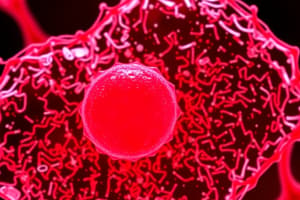Podcast
Questions and Answers
Explain the process of diffusion through a semi-permeable membrane and identify which molecules can pass through the cell membrane and why.
Explain the process of diffusion through a semi-permeable membrane and identify which molecules can pass through the cell membrane and why.
Diffusion is the movement of molecules from an area of high concentration to an area of low concentration. Small, nonpolar molecules like oxygen and carbon dioxide can pass through the cell membrane because they can dissolve in the lipid bilayer, while larger or charged molecules cannot pass through easily.
How were chemical indicators used in the diffusion through a membrane lab and what were the expected results?
How were chemical indicators used in the diffusion through a membrane lab and what were the expected results?
Chemical indicators were used to detect the presence of specific molecules. For example, iodine can be used to detect the presence of starch. The expected results would be a color change in the indicator when it comes into contact with the specific molecule.
Explain the initial and final states of Cell 1 & Cell 2 and why these results occurred.
Explain the initial and final states of Cell 1 & Cell 2 and why these results occurred.
The initial state of Cell 1 could be a higher concentration of a substance compared to the surrounding environment, while the initial state of Cell 2 could be a lower concentration. The final states would depend on the movement of molecules through the membrane. If Cell 1 had a higher concentration, molecules would diffuse out, while in Cell 2, molecules would diffuse in. The results occurred due to the process of diffusion trying to achieve equilibrium.
Describe the function of molecule X.
Describe the function of molecule X.
What must happen to starch for it to be usable and what is it used for as a dietary component?
What must happen to starch for it to be usable and what is it used for as a dietary component?
Explain the function of enzymes in speeding up chemical reactions.
Explain the function of enzymes in speeding up chemical reactions.
Describe the 3 steps of enzyme interactions.
Describe the 3 steps of enzyme interactions.
Discuss the effect of pH, temperature, and concentration of substrate on enzyme rate of reaction.
Discuss the effect of pH, temperature, and concentration of substrate on enzyme rate of reaction.
Explain the Lock and Key model of enzyme-substrate interaction.
Explain the Lock and Key model of enzyme-substrate interaction.
What determines the shape of enzymes and why is it important?
What determines the shape of enzymes and why is it important?
Flashcards are hidden until you start studying




